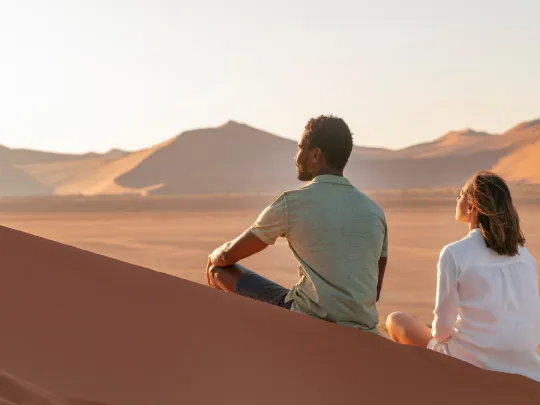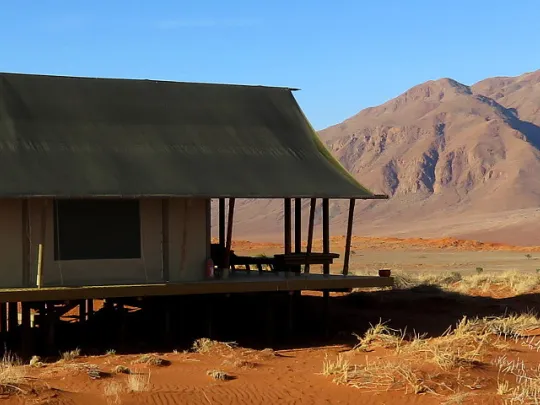Sossusvlei Dunes Travel Guide
Sossusvlei Dunes Travel Guide
Sossusvlei epitomises the exquisite desert experience of Namibia, with its endless sea of dunes. The blazing ochre Sossusvlei dunes rise up to over 320 m tall, making them some of the world's highest sand forms. These forever-shifting dunes, constantly reshaped by the wind into sandy valleys, slopes and peaks, form the ancient Namib Desert. The reds, oranges, yellows and caramel browns of the dunes and the bleached whites and washed-out pastel shades of the pans continuously transform with the turning seasons and the play of light which makes the desert landscapes glow at dusk and dawn.
Highlights
- Ancient desert terrain
- Ever-changing colours and shifting shapes
- The world's tallest orange dunes at Sossusvlei – iconic Dune 45, Elim Dune
- A silent, spacious, still landscape
- Incredible photo opportunities – like dramatic Dead Vlei landscape with its skeletal trees
- A wealth of different, unique and unusual flora and fauna
- Fascinating Sesriem Canyon
The Namib-Naukluft National Park in Namibia encompasses part of the world's most ancient desert – the Namib – and the Naukluft mountain range. Spanning an area of almost 50,000 square kilometres (just short of 20,000 square miles), the Namib-Naukluft is the largest game reserve in Africa and the fourth-largest in the world. Its best-known and main attraction is Sossusvlei – home to the world's highest sand dunes. Their distinctive burnt-orange hues signify their ancient age. The orange colour develops over time as the iron in the sand is oxidised, rather like rusty metal. The older the dune, the brighter the colour.

Climbing the Namib Desert's ancient sand dunes
'Namib' means 'open space' in the local dialect, giving its name to the country, Namibia, meaning land of open spaces. The Namib-Naukluft was established in 1907 when the German Colonial Administration proclaimed the area between the Swakop and the Kuiseb Rivers a game reserve. Its present boundaries were established in 1978 when the Namib Desert Park, the Naukluft Mountain Zebra Park, parts of Diamond Area 1 and certain other government land were merged.
The incredible fauna and flora that survive here
A surprising collection of creatures survive in this hyper-arid region, including snakes, geckos, unusual insects, hyenas, gemsbok and jackal. The moisture-laden fog off the Atlantic Ocean provides more moisture to the area than its average rainfall – scarcely more than 100 mm per year – which usually falls between February and April. The winds that bring in the fog also shape the massive Sossusvlei Dunes, the world's tallest, which rise to over 300 metres (almost 1000 feet) above the desert floor. The dunes thin out towards the coastline, where they are replaced by lagoons, wetlands and mudflats that attract hundreds of thousands of birds.

Oryx
Sossusvlei Dunes and Dead Vlei
Probably Namibia's most popular tourist attraction, the iconic Sossusvlei Dunes (Dune 45 is the most famous of these) are accessible by road from the Sesriem campsite. For avid photographers, the best time to capture the dunes is early morning or late afternoon when the shadows are stark and dramatic. The entire landscape is 'flattened' by the midday sunlight.
Every few decades, the cracked, parched earth of the Dead Vlei is flooded by the Tsauchab River, forming a shallow, turquoise lake, fringed with green vegetation. When water reaches the open pan, it transforms into a short-lived oasis, attracting an array of thirsty animals and birds in an otherwise arid and inhospitable land. A climb to the top of Dune 45 is a must-do when you visit Sossusvlei, as it provides endless panoramic views over the striking desert surroundings.
Exploring the desert on foot is the best way to fully absorb Namib's stunning imagery. Short walks include a hike to Hidden Vlei (4 km from the parking area and back) and to Dead Vlei (6 km from Sossusvlei and back).

Dead Vlei
The 5 km walk to Elim Dune makes a good early morning or late-afternoon walk, as does the climb up well-known Dune 45. Avoid the heat of the day and always remember to take plenty of water with you.
Sesriem Canyon
Also worth a visit, Sesriem Canyon is about 4 km from Sesriem itself. Carved by the Tsauchab River into sedimentary rock, it's about a kilometre (0.6 miles) long and up to 30 meters (100 feet) deep. Only two metres (6.5 feet) wide in some places, it has a section that permanently contains water, providing a much-needed water source for many animals.
Exploring the area
One of the most spectacular ways to explore the Namib Desert is by hot-air balloon, drifting over the endless sea of red-orange dunes. Flight safaris are also an excellent way to appreciate the sheer vastness and incredible landscapes of this unique country. You can drive to Sesriem, the solitary gateway to Sossusvlei Dunes, in a 2WD vehicle. The road to the parking area 4 km from the heart of Sossusvlei can also be navigated by 2WD but from there you'll need to walk or get a 4x4 shuttle. Elim Dune, Dune 45 and Hidden Vlei can all be reached by 2WD but walking is the most rewarding way to soak up the spectacular desert scenery.
Getting there
By air: The quickest way to get to the Namibrand and Sossusvlei region is by light aircraft. There are daily flights from Windhoek and Swakopmund.
By road: It's a good four-and-a-half hours' drive from Windhoek (306 km on dirt roads). The roads are generally in good condition and a road transfer gives you the opportunity to enjoy the wide-open landscapes of Namibia.
Sesriem Canyon
Sesriem (meaning six belts) is the name of a 30m deep Canyon carved into the desert rock by the Tsauchab river. It's a popular tourist attraction and you can walk along the sandy bottom of the canyon.
Sossusvlei Lodge
Sossusvlei Lodge is a large, midrange lodge situated near the entrance to the Namib-Naukluft National Park.
Sossusvlei

Sossusvlei epitomises the exquisite desert experience of Namibia, with its endless sea of dunes. The blazing ochre Sossusvlei dunes rise up to over 320 m tall, making them some of the world's highest sand forms. These forever-shifting dunes, constantly reshaped by the wind into sandy valleys, slopes and peaks, form the ancient Namib Desert. The reds, oranges, yellows and caramel browns of the dunes and the bleached whites and washed-out pastel shades of the pans continuously transform with the turning seasons and the play of light which makes the desert landscapes glow at dusk and dawn.
Sossus Dune Lodge
Sossus Dune Lodge is an upmarket tented camp on the edge of the Namib-Naukluft Park, close to Sossuvlei, with elevated views over the surrounding desert.
Kulala Desert Lodge

Kulala Desert Lodge and the exclusive Little Kulala are set in the private Kulala Wilderness Reserve, close to Namibia's famous Sossusvlei dunes, Dead Vlei and Sesriem Canyon. Local wildlife is remarkably adapted and endemic, from the stately gemsbok to the tiny 'barking' gecko.
Sossusvlei Desert Lodge

Sossusvlei Desert Lodge lies in the heart of Namibia’s ancient Namib Desert, where it offers guests serene silence and romantic luxury in an extraordinary, dramatic landscape. It’s a place of endless space, broad horizons and some of the most fascinating desert-adapted creatures on the planet.
Wolwedans Dunes Lodge
Wolwedans Dunes Lodge in the NamibRand reserve is a beautiful tented camp on the edge of the Namib Desert, with stunning views.
Desert Homestead Lodge
Desert Homestead Lodge is a remote, tranquil lodge within easy reach of Sesriem and Sossusvlei.
Desert Homestead Outpost
Desert Homestead Outpost is a beautiful lodge on a ridge overlooking the untouched wilderness of the Namib. Breathtaking views and within easy reach of Sossusvlei.
Hoodia Desert Lodge
Hoodia Desert Lodge is situated on the Tsauchab dry riverbed, about 20km from the entrance to Sossusvlei. The camp has 12 tented units overlooking the river and ridge beyond.
You may also want to look at

7 Day Namibia Fly-in Safari
This seven-day luxury fly-in safari explores some of Namibia's most iconic safari destinations – the distinctive ochre dunes of Sossusvlei, the rugged, desolate landscape of Damaraland and the Kaokoveld, where you're likely to spot the legendary desert-adapted elephant, and Etosha, Namibia's ancient national park. Flying over this vast country, you'll also get an insight into its fascinating details and incredible landscapes.

9 Day Best of Namibia Safari
Discover Namibia's most iconic landscapes and wildlife with a top nature guide on this expertly planned 9-day safari. From the towering red dunes of Sossusvlei and the wild Atlantic shores of Swakopmund to the rugged beauty of Damaraland and the wildlife-rich plains of Etosha National Park, this small-group tour offers a comprehensive introduction to Namibia. Prefer a private trip? We can tailor the itinerary to suit your interests.

Sossusvlei Desert Lodge, Namib Desert
Sossusvlei Desert Lodge lies in the heart of Namibia’s ancient Namib Desert, where it offers guests serene silence and romantic luxury in an extraordinary, dramatic landscape. It’s a place of endless space, broad horizons and some of the most fascinating desert-adapted creatures on the planet.
















